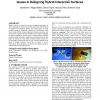Free Online Productivity Tools
i2Speak
i2Symbol
i2OCR
iTex2Img
iWeb2Print
iWeb2Shot
i2Type
iPdf2Split
iPdf2Merge
i2Bopomofo
i2Arabic
i2Style
i2Image
i2PDF
iLatex2Rtf
Sci2ools
104
click to vote
BCSHCI
2009
2009
Putting the physical into the digital: issues in designing hybrid interactive surfaces
Hybrid surfaces are interactive systems combining techniques of direct-manipulation multi-touch surface interaction with elements of tangible user interfaces (TUIs). The design space for such complex hands-on computing experiences is sufficiently broad that it can be difficult to make allocation of function decisions and decide when interface elements should be given either a physical or digital instantiation and the extent to which different interface functions should be made to model real-world interactions. In this paper we present two case studies of hybrid surface systems we are developing and discuss how we have reasoned through these kinds of design decisions. From this we derive a set of observations about properties of physical and digital elements, and offer them as a design resource. Categories and Subject Descriptors H5.m. Information interfaces and presentation (e.g., HCI): Miscellaneous. General Terms Design, Human Factors. Keywords Hybrid surfaces, Tangibility, Direct-t...
BCSHCI 2007 | BCSHCI 2009 | Direct-manipulation Multi-touch Surface | Hybrid Surfaces | Tangible User Interfaces |
Related Content
| Added | 08 Nov 2010 |
| Updated | 08 Nov 2010 |
| Type | Conference |
| Year | 2009 |
| Where | BCSHCI |
| Authors | David S. Kirk, Abigail Sellen, Stuart Taylor, Nicolas Villar, Shahram Izadi |
Comments (0)

